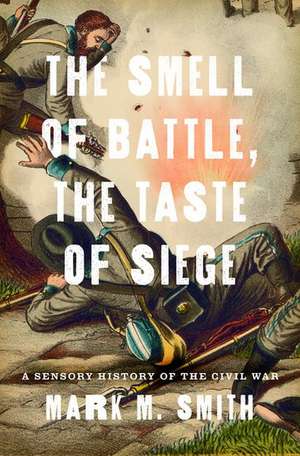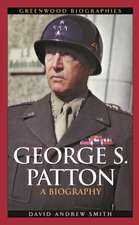The Smell of Battle, the Taste of Siege: A Sensory History of the Civil War
Autor Mark M. Smithen Limba Engleză Hardback – 13 noi 2014
| Toate formatele și edițiile | Preț | Express |
|---|---|---|
| Paperback (1) | 106.10 lei 3-5 săpt. | |
| Oxford University Press – | 106.10 lei 3-5 săpt. | |
| Hardback (1) | 361.86 lei 31-38 zile | |
| Oxford University Press – 13 noi 2014 | 361.86 lei 31-38 zile |
Preț: 361.86 lei
Preț vechi: 475.15 lei
-24% Nou
Puncte Express: 543
Preț estimativ în valută:
69.24€ • 72.29$ • 57.31£
69.24€ • 72.29$ • 57.31£
Carte tipărită la comandă
Livrare economică 24-31 martie
Preluare comenzi: 021 569.72.76
Specificații
ISBN-13: 9780199759989
ISBN-10: 0199759987
Pagini: 210
Ilustrații: 16 illus.
Dimensiuni: 147 x 211 x 23 mm
Greutate: 0.34 kg
Editura: Oxford University Press
Colecția OUP USA
Locul publicării:New York, United States
ISBN-10: 0199759987
Pagini: 210
Ilustrații: 16 illus.
Dimensiuni: 147 x 211 x 23 mm
Greutate: 0.34 kg
Editura: Oxford University Press
Colecția OUP USA
Locul publicării:New York, United States
Recenzii
Smiths choice of episodes is inspiring. Perhaps not evident from the last two chapters titles, themes are introduced with playful language, his enjoyment in writing this volume evident throughout ... I would be surprised if this book does not change historical accounts of warfare. The twentieth century brought total war to greater numbers of civilians of many other nations, but historians have yet to write the sort of total history, which adequately conveys the full meaning of such collective trauma. Yet again, Smith has provided us with a model.
Read this book for an original methodology that encourages readers to consider the influence of the confusions of battle, the noise of shells, and the stench of death. Smith describes some of the key encounters of the civil war, including the Battle of Bull Run and Gettysburg, in terms of assaults on the senses and shows how that affected outcomes.
Historians often ask readers to imagine the intense sights, sounds, and smells of battle. Smith goes one step further and explores how such sensory assaults affect the conduct of war itself.
Read this book for an original methodology that encourages readers to consider the influence of the confusions of battle, the noise of shells, and the stench of death. Smith describes some of the key encounters of the civil war, including the Battle of Bull Run and Gettysburg, in terms of assaults on the senses and shows how that affected outcomes.
Historians often ask readers to imagine the intense sights, sounds, and smells of battle. Smith goes one step further and explores how such sensory assaults affect the conduct of war itself.
Notă biografică
Mark M. Smith is Carolina Distinguished Professor of History at the University of South Carolina and author or editor of a dozen books, including Sensing the Past: Seeing, Hearing, Smelling, Tasting, and Touching in History and How Race Is Made: Slavery, the Senses, and Segregation.














